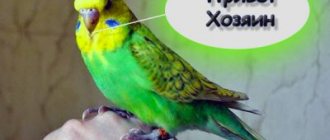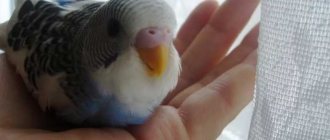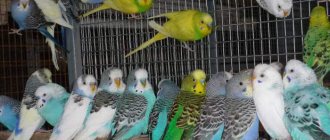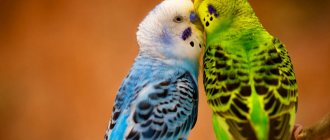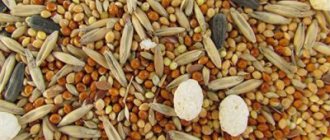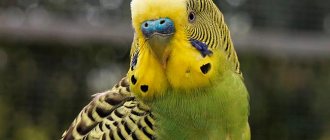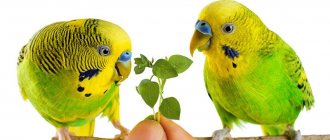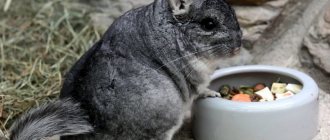In nature, budgies bathe whenever they want: they take a “shower” during the rain, splash in puddles, and water their feathers in wet grass. But is it worth washing a tame bird that lives in a cage? First of all, you should take a closer look at your pet and understand whether it needs bathing. You can help keep budgies clean at home; many ways have been invented for this.
Is it necessary or not to organize a bath day?
Some budgies are not known for being clean and refuse to wash themselves voluntarily. This happens for various reasons. This is often done by young individuals who have recently arrived in a new home and are still afraid of the environment and do not make contact with the owner.
The second reason may be a stressful situation related to water. Perhaps one of the household members inadvertently gave the bird a cold shower or unexpectedly sprayed it with a direct stream from a tap or spray bottle. In this case, you need to wait a while and again offer the parrot a swim.
In such a situation, the question of how to tame a budgie to swim becomes especially acute. The bird should stop being afraid of moisture. Clean drinking water and filled bird baths should always remain in the cage within the parrot's field of view. If your pet does not pay attention to the filled containers, you can gently spray warm water around it and observe the reaction. If a bird likes the semblance of tropical rain, then soon it will happily splash around in its own bath. If it was not possible to bathe the wavy one in this way, you will have to find another method.
When can a bird be released from its cage?
On average, a parrot needs about 2-3 weeks to adapt. During this time, he gets used to the environment and interior items. The latter also act as landmarks during flight. If the bird is released early during a period of stress, it can cause serious injury to itself.
In the best case, the pet will get stuck somewhere in a hard-to-reach place, and in the worst case, it will damage its wings or paws. Moreover, the bird will most likely completely refuse to return to the cage, and catching it will aggravate the stressful condition.
Birds are less excited in the afternoon. Therefore, it is better to release them from the cage in the late afternoon. At the same time, it is necessary to monitor the first flights of the parrot, and, if necessary, help him.
Before releasing the bird, you need to prepare the room:
- Close all the windows and doors, and cover the windows with daytime curtains.
- Clear the room of dangerous objects.
- Move the plants to another room.
- Block access to closets and other places where the bird can hide.
- Remove decorative decorations suspended on threads: airplanes, balls, toys, etc.
Budgerigars will test all interior items for strength, so valuable things, such as household appliances or expensive sets, should also be moved to another room.
How to properly bathe a parrot
For those new to avian hygiene, it is extremely important to know how to teach your budgie to bathe. The main thing is not to force him and turn the whole process into a game. For example, you can take a small bowl of water a little warmer than room temperature and place it near the cage. Open the door slightly and splash your hands in the water, creating small waves. The parrot will definitely be interested in this process, and it will fly closer to better see what the owner is doing. When the bird becomes bolder and feels free near the impromptu pond, you can sprinkle a few drops of water in its direction. If the bird likes this procedure, over time it will get used to the bathing suit.
There are several more proven ways to bathe budgies at home:
- Accustom the bird to wash itself in the bathhouse from the first days of its stay in the house. This is the easiest and safest way to wash budgies. The size and depth of this container is designed for a small bird; it will not choke or drown in it. The bathing suit should always be filled with clean, warm water and kept in a cage: in this case, the parrot will not consider the container with water something dangerous and scary.
- Spraying water from a spray bottle is one way to bathe a parrot. In this case, natural instinct will work - in the homeland of parrots it often rains warmly, under which they clean their feathers. By imitating this natural phenomenon at home, you can wash the wavy one without any problems.
- When your parrot is moving freely around the room, you can open the tap in his presence and watch the bird’s reaction. The sound of water will remind him of the sounds of rain, and the parrot will become interested in the iridescent liquid. There are often cases when a budgerigar is bathed only under a tap or shower, and the bird does not experience the slightest discomfort.
- The most natural and unusual way to wash budgies is bathing in plants. Well-washed, wet greens are placed in the cage, usually garden or vegetable herbs. This method is 100% suitable for parrots: this is how they bathe in nature, in the dew of green thickets.
What can be used as a bath
Special baths can be open or closed (with a transparent dome that retains splashes). They produce models with a fountain or shower included. If there is no such bath or the parrot flatly refuses to wash in it, it is easy to find a replacement from household utensils.
Any wide container with low sides is suitable for a bath - a deep plate, a saucer, a small plastic container. It is important that the pet is comfortable. And if the parrot ignores a luxurious bath and willingly splashes around in a nondescript plate, you should allow him to bathe where he likes.
Is it possible to force a parrot to wash itself?
Bathing a budgie is an absolutely natural and natural process. Birds have a natural love for water procedures. But there are individuals who are absolutely indifferent to water. Finding a way to get your pet to bathe will not work. The parrot can clean its feathers itself, and the presence of water in the bath will sooner or later encourage the bird to take water treatments.
Don’t be upset if it’s almost impossible to get your budgie to swim at home. Perhaps his dislike of water is his individual trait.
Useful tips
When taming a pet, do not wave your hands over its head. This is due to the fact that they have a reflex that a flicker from above is the shadow of a bird of prey. As a result, an association will arise: hand – danger. It will be impossible to retrain the bird.
https://youtube.com/watch?v=xBMTWd9uTYg
https://youtube.com/watch?v=xBMTWd9uTYg
Training is a rather lengthy process. Some wavy animals become tamed only at one year of age. You cannot punish a bird if it bites. This is an adequate reaction to an invasion of personal space. Or the pet is defending itself. In such a situation, try to calm the parrot in an even voice or move away from him. After some time, the procedure can be repeated.
You should not lure the bird with treats when it is just starting to leave its cage. In addition, you should not grab it suddenly. The purpose of taming is to make the pet not afraid of your palms. If you do everything right, you can quickly win the love and trust of your feathered friend.
Conditions for home ablutions
Ornithologists are often asked whether it is possible to bathe a budgie in an apartment. Experienced breeders of Pied Birds answer in the affirmative. It is only necessary to observe the temperature regime during water procedures.
Note: the air temperature in the room should not be lower than +25°C.
The water temperature is not colder than room temperature. It is important to protect your pet from drafts and wind. Usually a budgerigar bathes in a special bath and copes with its hygiene without the participation of strangers.
If the bird is an old-timer at home, trusts the owner and makes good contact with him, in this case, bathing under the tap or shower is organized for the budgies. These pets feel great in a regular car wash. The problem may be too much pressure, unregulated water temperature or loud noise. In this case, turn off the water - the moisture that remains on the walls of the sink is enough to bathe the bird.
Bird breeders are also faced with the question of whether it is possible to wash birds in a drinking bowl. Parrots love to bathe in a container intended for drinking, even if there is a bath nearby. It is unlikely that you will be able to wean your feathered pet from this habit, so all that remains is to change the water after each such “swim”.
Preparation for the procedure
An important condition for carrying out water procedures is that the bird has a good mood and trust in its owner. For bathing, you need to prepare a small container of water or a sink.
Tips and recommendations for preparing your pet bird for a bath:
- The water must be warm and suitable for drinking, because... the bird may decide to drink it;
- It is recommended to bathe your pet in a dimly lit room so that he can relax;
- the distance from the edges of the container to the water should not be less than 2 cm;
- All windows in the apartment should be closed and the air conditioner should be turned off. You cannot wash your parrot at room temperatures less than 20 degrees;
- If the feathers are heavily soiled, add a special bird shampoo to the water. If you don't have it, you can use fragrance-free baby shampoo. For simple rinsing of feathers, chamomile infusion is suitable;
- When your pet tries to escape, you need to wrap yourself in a sheet or towel. During washing, the owner must hold the torso and the area in the cheek area;
- If a bird gets dirty in a sticky chemical, the feathers must be cut off if washing is impossible. During self-cleaning of the plumage, the pet may become poisoned. Do not clean feathers using solvents or other cleaning agents. They are very toxic and can cause the death of a bird.
How often to bathe a bird
Another problem for new owners of a motley bird is whether it is necessary to bathe the pet on purpose and how often to do it. You should not deliberately try to bathe the bird. Natural instinct itself will tell the bird how to wash its feathers. A person only needs to offer his pet one or another bathing option. The owner’s task is to provide the bird with clean, warm water on an ongoing basis. A filled bath should always be in the cage.
It should also be taken into account that swimming is not only a hygienic procedure for birds, but also a fun pastime and a water attraction. The more often a parrot splashes in the water, the better its mood, good spirits and health. There is no need to limit water treatments for your pet.
Peculiarities
The owner of a bird needs to know how to bathe a bird without consequences. To do this, you should know some prohibitions and taboos for bird water procedures.
- Bathing budgerigars should take place in specially sized baths. Containers that are too large and deep, intended for larger birds, can become a source of danger for small birds.
- The room should be warm and dry. When swimming, birds indoors close all windows and doors.
- If bathing takes place in a bathtub or sink, there should be an owner nearby who knows how to wash the bird without consequences.
- After the budgie has bathed, it should not be dried. The bird will dry itself naturally, and using a hairdryer or fireplace will only harm the bird’s skin. Also, after buying budgies, it is not recommended to dry them with a hard towel - this can ruin the plumage.
Note: the water in the bath should always be warm, especially in the cold season.
The owner of the bird needs to know how to bathe a budgerigar easily and without consequences at home. This knowledge is necessary for a person to create the right living conditions for a feathered friend. It is impossible to force a budgie to bathe, but there are many ways to teach it to love water. Water procedures are the key to a healthy and happy life for a motley parrot. Watching the water games of feathered pets will bring a lot of positive emotions to their owner.
Cage care
Clean the cage at least twice every week. To do this, use warm water. It should not contain any substances that you usually use in everyday life for cleaning or cleaning anything. That is, do not use powders, floor liquids, etc. to care for your parrot’s home. Make sure you have a cleaning brush. For example, an unnecessary, used toothbrush is perfect for these purposes.
After you wash all the things that are in the cage, do not forget to wipe them with a dry cloth. The dirtiest part of a bird's home is the tray. Therefore, clean and wipe it thoroughly. When the cleaning is completed, you can place new paper on the bottom of the clean cage or sprinkle special sand purchased at the pet store.
